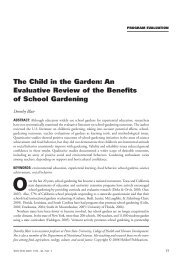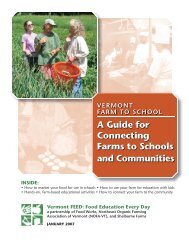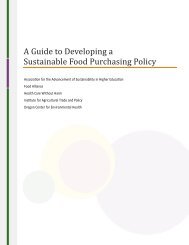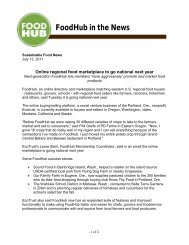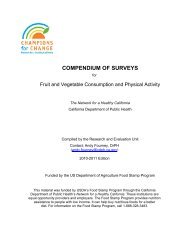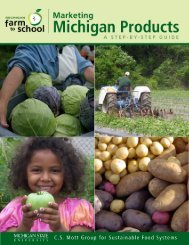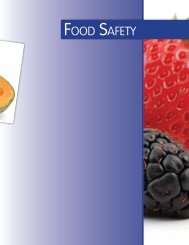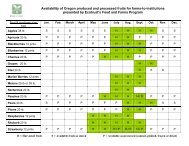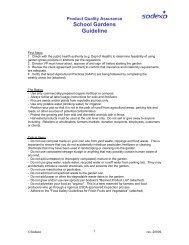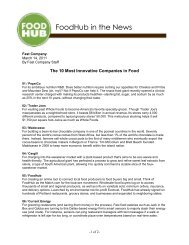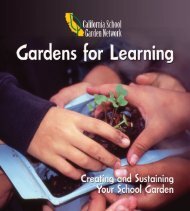eval report cover.indd - New Jersey Farm to School Network Wiki
eval report cover.indd - New Jersey Farm to School Network Wiki
eval report cover.indd - New Jersey Farm to School Network Wiki
Create successful ePaper yourself
Turn your PDF publications into a flip-book with our unique Google optimized e-Paper software.
Comparative Research: Salad Bars and Produce ConsumptionSalad bars and fruit and vegetable consumption in elementary schools: A plate waste study. Adams MA,Pelletier RL, Zive MM, Sallis JF. Journal of the American Dietetic Association. 2005; 105:1789-1792.Review of <strong>Farm</strong> <strong>to</strong> <strong>School</strong> Evaluation LiteratureTh is small study examined diff e rences in fruit and vegetable consumption between self-servesalad bars and proportioned meals. The study was conducted in two San Diego County schooldistricts with diff e rent food offerings. Using food plate waste data from 288 students at fourschools, the researchers found no significant diff e rence in fruit and vegetable consumptionbetween students that served themselves and those that were served proportioned items.Th e variety of items available did impact consumption as the lunch program with thegreatest number of fruit and vegetable offerings also had the highest consumption.Students choose farm <strong>to</strong> school meals over hot meal options►►►In the Ventura Unified Healthy <strong>School</strong>s Program (VEN-CA), students chosefarm <strong>to</strong> school salad bar meals at a ratio of approximately two <strong>to</strong> one over hotmeal entrees. Th e salad bar was more popular than all twelve hot entrees offeredon salad bar days (2002-03 data). 49In March 2005 when the RSD-CA farm <strong>to</strong> school salad bar program was initiated,a record 65% of students chose the salad bar lunch over hot lunch. Afterthe initial excitement wore off, participation numbers leveled off <strong>to</strong> 26%, wherethey have remained since then. An unexpected result of the program has been anearly 9% increase in overall school meal participation, including growth in thenumber of teacher meals served. Prior <strong>to</strong> the salad bar, the school served approximatelysix teacher meals per month, post-salad bar they served an averageof 11 teachers per day nearly all of whom eat salad bar lunches. This growth inparticipation has resulted in a substantial increase in revenues that help makethe program financially sustainable.In the COM-CA program, two farm <strong>to</strong> school sites had an average of 54.6% and21.9% of students choosing salad bar meals over hot meals. 20Students self-<strong>report</strong> healthier diets by an increase in consumption of fruits andvegetables and healthy foods or a decrease in consumption of unhealthy foods►Students participatingin the Los Angeles Unifie d Salad Bar Project(LSB-CA) from 2000-01 <strong>report</strong>ed that theyate an average of 4.09daily servings of fruitsand vegetables after afarmers’ market saladbar was introducedat their school compared<strong>to</strong> 2.97 servingsper day before the34 Bearing Fruit: <strong>Farm</strong> <strong>to</strong> <strong>School</strong> Evaluation Resources and Recommendations



